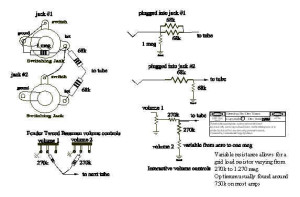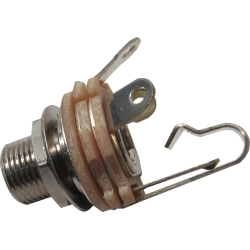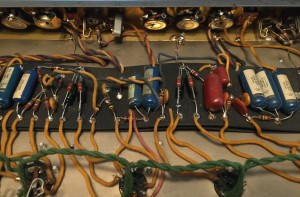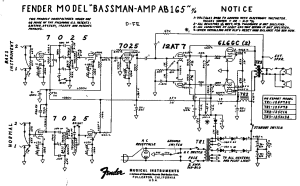I recently picked up a 1967 Fender Bassman amp from a guy in Florida. Even though it sounded fairly nice…..
You can hear from the video above, that it has a nasty hum, even with no guitar plugged into it when turned up. I really didn’t want to send it back, since it is in excellent shape and has been modified from the CBS AB165 circuit to the Leo Fender AA864 circuit, so my work on this amp will be fairly minimal.
*** Do NOT attempt this unless you are qualified to do so. These amps have LETHAL voltages inside of them that can easily kill you and turn you to charcoal! If you don’t know what you are doing, do yourself a favor and call an engineer! ***
The first step was to build an amp ‘stand’, so that I could remove the chassis from it’s cab and hook it up to a speaker so that I might trouble shoot it. 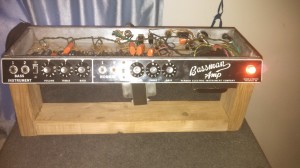 You can see that here. The measurements for the stand are cut from a standard 2 by 4 and the base is 18.25 inches and the sides are 7 inches and screwed onto the ends of the base. You can also cut two 5.5 inch pieces that will make the stand narrower by setting one or both on the inside and using a rubber band to hold it or them in place. (In case you wish to use this ‘stand’ on an amp chassis that might be narrower. 😉
You can see that here. The measurements for the stand are cut from a standard 2 by 4 and the base is 18.25 inches and the sides are 7 inches and screwed onto the ends of the base. You can also cut two 5.5 inch pieces that will make the stand narrower by setting one or both on the inside and using a rubber band to hold it or them in place. (In case you wish to use this ‘stand’ on an amp chassis that might be narrower. 😉
The most common causes for that kind of hum can be found by either basic trouble shooting or a visual inspection. First, to rule out the V3 tube that is on the guitar channel only, I swapped it with V1, the input tube of the bass channel. No change. So, next, I really spent a few good minutes inspecting the normal channel’s input stage circuitry, as you can see in this pic, if you click on it, I have marked a couple areas that appear to be problematic. The areas I have circled on the board is  where the Normal channel input tube’s circuitry is located, and has many suspect solder joints. The bundle of wires that I circled, is of interest because it contains the wiring coming from the input jack as well as the wiring to/from the output transformer, and is a perfect example of very poor ‘lead dress’.
where the Normal channel input tube’s circuitry is located, and has many suspect solder joints. The bundle of wires that I circled, is of interest because it contains the wiring coming from the input jack as well as the wiring to/from the output transformer, and is a perfect example of very poor ‘lead dress’.
I also took a couple voltage  measurements, which I felt entirely unnecessary, and just served to prove that V3 (Guitar channel input triode) was operating properly. The measurements were: pin 1: 238V, pin 3: 1.9V, pin 6: 221V, and pin 8: 1.6V (all voltages are volts DC). This tube stage is operating fine, so the hum must be coming from the input jacks, or the tone stack, both of which had visually detected problems.
measurements, which I felt entirely unnecessary, and just served to prove that V3 (Guitar channel input triode) was operating properly. The measurements were: pin 1: 238V, pin 3: 1.9V, pin 6: 221V, and pin 8: 1.6V (all voltages are volts DC). This tube stage is operating fine, so the hum must be coming from the input jacks, or the tone stack, both of which had visually detected problems.
Below is a video that absolutely proves that your first and best bit of troubleshooting is your visual checks. 😉
Still a small amount of work to do….. Clean up the sloppy soldering on the board (may as well go over the whole amp, resoldering any suspect joints) and also remove that ‘death’ cap, but now, this amp sounds really nice and LOUD!
Keep your eyes peeled here, as I fully intend to go over some Bassman modifications that will get some great results when applied to an AB165 blackface OR silverface amp. 😉

